Want our FREE “Home Grain Milling 101” eBook? Click here to download the “Home Grain Milling 101” eBook for FREE!
You want lighter baked goods? Like fluffier bread and light cookies?
Besides using fresh-ground flour, there’s another thing you can do to achieve this. You can make your own “all-purpose” flour at home…. by sifting!
It’s not exactly like the store-bought all-purpose flour (we can’t get it that fine), yet it really works to give you lighter baked goods!
So on today’s #AskWardee, I’m showing how to sift flour into your own homemade all-purpose flour!
Subscribe to #AskWardee on iTunes, Stitcher, YouTube, or the Podcasts app.xx
The Question: How To Make All-Purpose Flour By Sifting
Jeannette R. asked:
If you use Einkorn flour and mill it yourself in your Mockmill, do you only bake with the whole wheat flour? How do you make it into all-purpose flour?
Thanks for this question, Jeannette. 🙂
What Type Of Flour I Bake With
I bake with all whole grain, a combination of whole grain and sifted, or sometimes all sifted flour.
For our hearty bread, I stick to whole grain. This Whole Grain Primer will teach you about the different grains, their uses, and nutrition.
If it’s a pastry item, I often sift or use a combination of sifted and whole grain.
Wait! Isn’t Sifted Flour Unhealthy?
I know, I know…
In whole grain circles, everyone says that non-whole grain flour isn’t as healthy. Because it’s not 100% whole grain anymore.
Right? You’ve heard it, too?
Part of that is true. But it’s not the whole story.
Besides the fact that sifted flour helps you achieve lighter baked goods, there are two health consequences from it. One is good, the other is bad. Neither are the end of the world. 🙂
One is that, sifted flour being more like all-purpose flour, it is more refined than whole grain and therefore may have more of an impact on blood sugar. (So combining with some whole grain or using it in true sourdough recipes, where the starch is reduced, can help mitigate this.)
Second, when you sift flour, as I’m going to show you, you are removing the tougher, outer part of the grain called the bran. The bran is what contains the anti-nutrient phytic acid. (Phytic acid binds to minerals and prevents their absorption, leading to mineral deficiencies.) So in this way, you’re actually making the grain healthier, if you’re not going to use it in a sourdough recipe that would otherwise neutralize the phytic acid.
So you see, it’s not quite cut and dried. There are benefits to using sifted flour just as there are benefits to using whole grain flour.
You have to take all the factors into consideration, such as your desired end result and the method of preparation (such as sourdough).
And thus, I give you permission to make your own homemade all-purpose flour… by sifting!
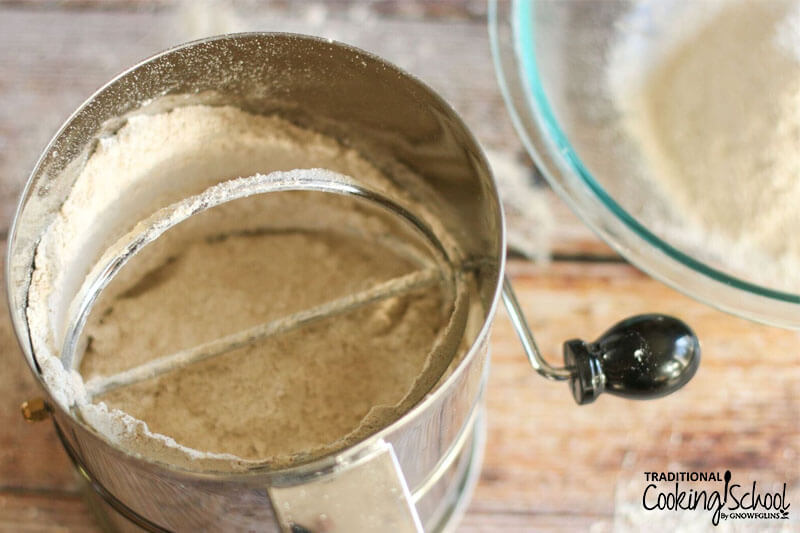
How To Sift Flour a.k.a. How To Make All-Purpose Flour
If you do decide that using some or all sifted flour (a.k.a. “all purpose”) in your kitchen is something you want to do, here’s how to do it.
By the way, you can do this with freshly ground flour —OR— flour that’s been sitting around awhile. In fact, freshly-milled flour is already pretty light and fluffy like sifted flour! You can get it even lighter by sifting, though.
Personally, I prefer using freshly ground flour AND sifting when needed. (In #AskWardee 118, I showed how much flour to grind for your recipes.)
I mill flour with the Mockmill. It’s a great, afffordable home stone grain mill that’s attractive on your counter and can produce flour on-demand for whatever you’re baking! See info about the Mockmill below.
And for sifting I use this 8-cup hand-crank sifter.
The steps are:
- Mill your flour (if using freshly ground). Generally, if grinding fresh, you need about half as many berries as cups of flour called for. So if the recipe calls for 2 cups of flour, you’ll grind 1 cup of berries. If you’re sifting, you may need to grind a bit more to account for what’s sifted out.
- Put the flour in the sifter a bit at a time, while the sifter is over an empty large bowl.
- Turn the crank on the sifter and the sifted flour will fall out into the bowl, while the chaff and tough stuff will stay in the sifter.
- Turn the tough stuff out of the sifter (into the compost, if you don’t want to waste it).
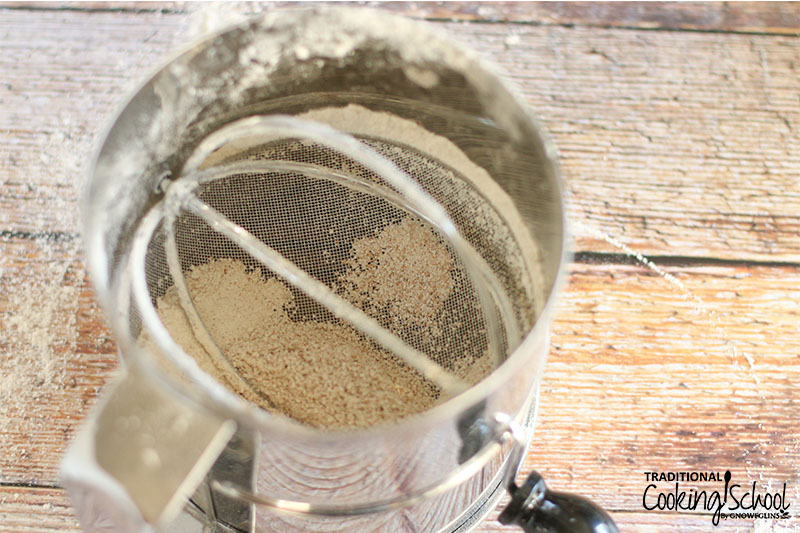
- Repeat until all flour is sifted.
- Yay! You just made “all purpose” flour at home… or close enough!
My Favorite Grain Mill: The Mockmill
As you can tell from this series, the Mockmill is my favorite grain mill and the one I recommend! I’ve been recommending it for a year and lots of you have already gotten one in your homes. Mockmill tells me you’re very happy and I’m glad about that. 🙂
The Mockmill is a home stone grain mill, and it’s engineered and manufactured in Germany by Wolfgang Mock. He started making home grain mills back in the 1970s, so he’s been doing it for over 40 years. It’s estimated that nearly 70% of the stone mills out there are made by him.
This mill is super exciting because it contains the best features of Wolfgang Mock’s milling career, yet it’s much more affordable. The reason it’s more affordable is because this mill comes in a durable recycled material housing (instead of expensive wood).
I love the Mockmill because it produces super healthy freshly-ground flour with a really fine texture. It doesn’t warm the flour up like some mills do, so the flour is more nutritious. Finally, the flour yields wonderful, light bread!
This mill will also grind all grains, even gluten-free. It can even crack grains for porridge, and it has many other uses (like some spices, nuts, and seeds). Are you ready to unbox your own Mockmill?
See How The Mockmill Works In This Video…
All the details — including the very affordable price and FREE SHIPPING — are on this page. By the way, it also comes as a KitchenAid attachment — very exciting for those who don’t want another appliance to take up any more room!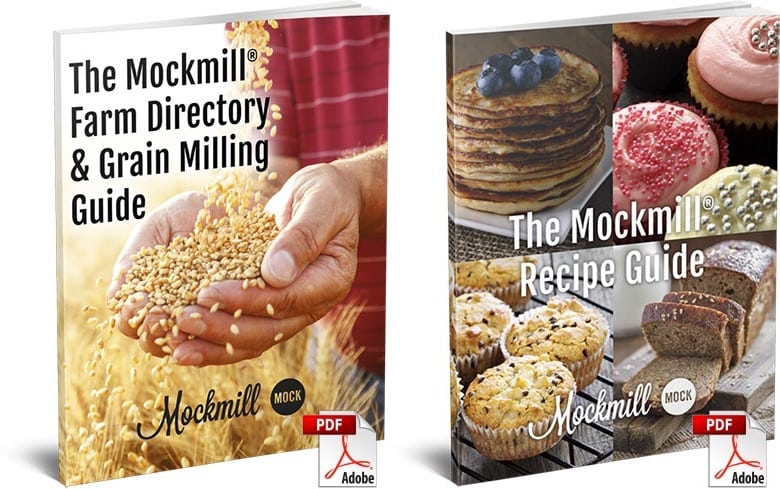
Also with your purchase of the Mockmill, you’ll get two fantastic eBooks from the Mockmill team: The Mockmill Farm Directory & Grain Milling Guide and The Mockmill Recipe Guide. Both of these eBooks are fabulous!
And, for a limited time… if you decide to purchase the Mockmill, I’m ALSO throwing in complimentary copies of both my Sourdough A to Z and Einkorn Baking eBook and Video Packages. They’re each worth $64 for a total of $128 in additional bonuses from me.
To claim your extra free bonuses from me after purchasing the Mockmill, just go to tradcookschool.com/millbonus. Have your order # handy, because you’ll need it to claim the two free eBook packages! (Your bonuses from Mockmill will come from them.)
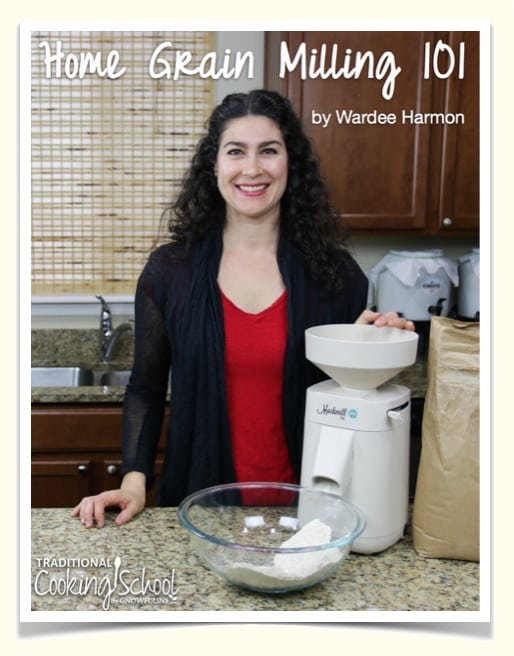 Want our FREE “Home Grain Milling 101” eBook? Click here to download the “Home Grain Milling 101” eBook for FREE!
Want our FREE “Home Grain Milling 101” eBook? Click here to download the “Home Grain Milling 101” eBook for FREE!
Helpful Links
- The Mockmill — my favorite and recommended (affordable) home stone grain mill — Hurry! The limited time offer to get my eBook packages valued at $128 won’t last long!
- Claim your FREE ($128 value) bonuses from me with your purchase of the Mockmill here!
- 8-cup hand-crank sifter
- Free “Home Grain Milling 101” eBook — our entire 4-part series combined into a single, FREE download from me!
- Home Grain Milling 101, Part 1: The Basics
- Home Grain Milling 101, Part 2: Milling Gluten-Free Grains Into Flour
- Home Grain Milling 101, Part 3: Baking With Fresh Ground Flour
- Home Grain Milling 101, Part 4: More Fun Things Your Grain Mill Can Do!
- Where To Buy Whole Wheat Berries, Grains, and Flour #AskWardee 148
- How To Store Flour & Grains #AskWardee 149
- Do Sprouting, Culturing, Or Sourdough Reduce Carbs? AW905
- FREE Webclass: Baking With Fresh-Ground Flour
- FREE No-knead Sourdough Einkorn Bread Recipe
- Why I <3 Einkorn — in case you want to know why we bake with the healthier 5,000 year-old wheat called einkorn!
- Where To Buy Einkorn
Did you know how to sift flour? Do you often bake with homemade all-purpose flour? Share your thoughts and/or tips in the comments!
We only recommend products and services we wholeheartedly endorse. This post may contain special links through which we earn a small commission if you make a purchase (though your price is the same).

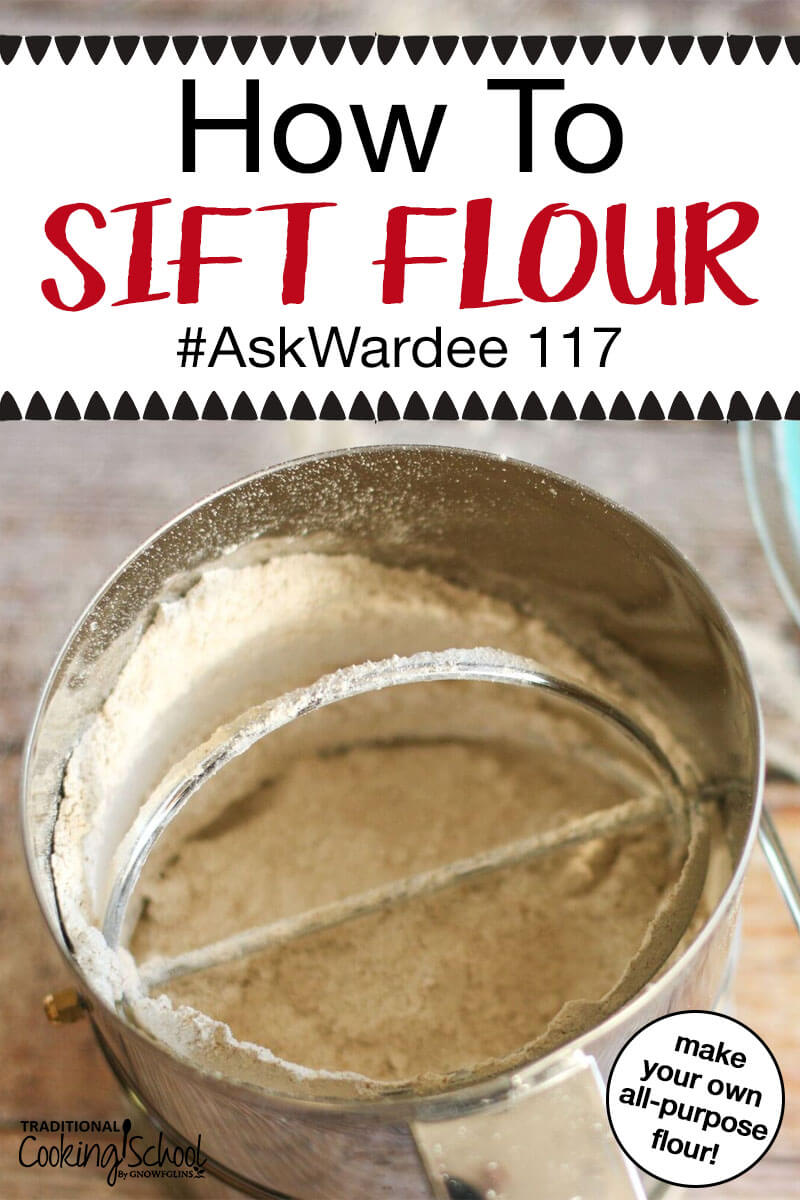



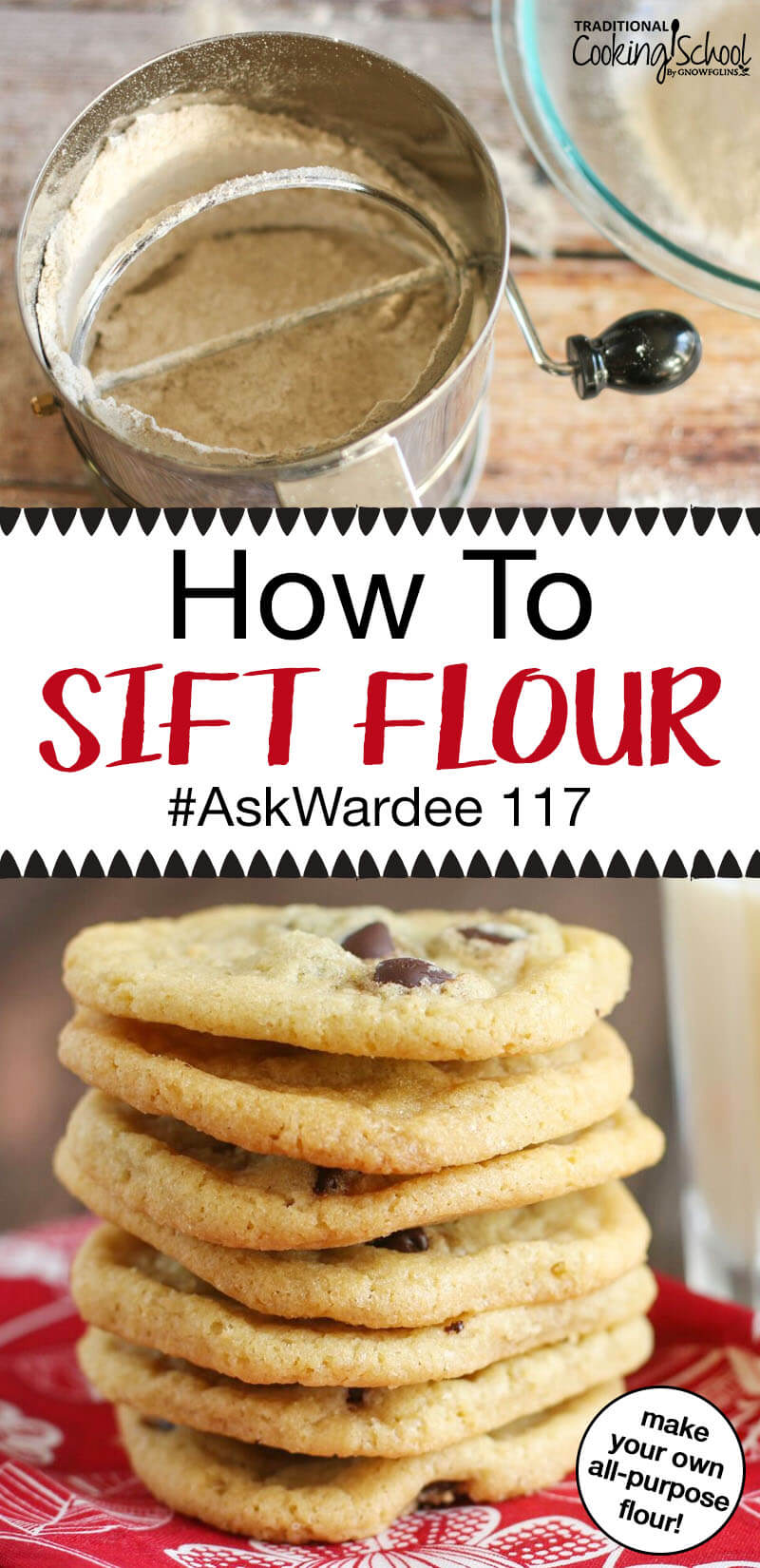
Can you recommend a smaller flour sifter?
Can you use the bran in fermented cereals?
Hi Linda,
Here’s a 5-cup sifter: https://amzn.to/2EAKEh4
Yes, you could use the bran in fermented cereals. 🙂
~Danielle, TCS Customer Success Team
I am sprouting einkorn berries. I will then grind them in my manual grain mill. If I sift this flour will it be the same as the einkorn all purpose flour you can buy? https://www.azurestandard.com/shop/product/food/flour/einkorn-flour/einkorn-all-purpose-flour-organic/24514?package=FL344
Thanks,
Deb
Hi, Deb.
Wardee mentions sifting sprouted flour in the video. 🙂
Once you dry and grind your sprouted berries you can sift them.
Home sifted flour in small batches is not as refined as store-bought but the quality will be better as will be fresher.
~Danielle, TCS Customer Success Team
What about the endosperm? I would guess that it is not sifted out, therefore this A/P flour is not as shelf-stable as the flour you get in the store. This just has the bran sifted out of it. Is that right?
Hi, Sheri,
Both store bought and freshly milled flour contain the endosperm. The endosperm takes up approximately 80-85% of the grain so after sifting you will have the endosperm in the flour. Store bought is rancid by the time it reaches the consumer. Home-ground, when ground on-demand is the best way to ensure it is fresh. Otherwise it is best to keep it in a cool location or in the freezer after grinding.
~Peggy, TCS Customer Success Team
Hello, Is there a quality sifter to make all-purpose flour that you can recommend. The ones above have some bad reviews. Thank you, Mike
Hi, Michael,
The sifter she shows above is the one she uses and recommends.
~Peggy, TCS Customer Success Team
Do you use the same usual finest flour setting to grind the flour that you will sift? Wouldn’t the finest flour setting merely make the bran and germ so small that it goes through the sifter?
Yes, you would still use the finest setting.
Home-milled flour will never be as fine as commercially milled grain so you will still have a siftable flour. ?
~Danielle, TCS Customer Success Team Lead